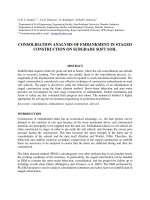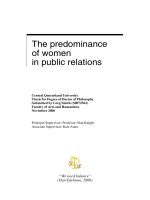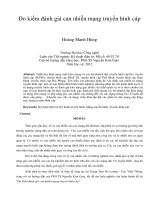The analysis of triclosan in toothpaste
Bạn đang xem bản rút gọn của tài liệu. Xem và tải ngay bản đầy đủ của tài liệu tại đây (41.35 KB, 6 trang )
The Analysis of Triclosan in Toothpaste
via LC/FT-IR Mobile Phase Elimination AN-20
Introduction:
Triclosan (Figure 1), an anti-bacterial agent used to prevent gum disease, was qualitatively analyzed in toothpaste using
liquid chromatography for separation and FT-IR for identification. An LC-Transform interface was used to remove the
HPLC mobile phase and collect the sample for FT-IR analysis. The determination of components in dental and other
cosmetic products is useful and often mandated by the manufacturer and by regulatory agencies. In this case the positive
identification of triclosan in every batch of toothpaste is necessary as governed by good manufacturing practices (GMP).
HPLC-FTIR can replace wet chemistry methods as a faster, simpler means of identification.
Figure 1.
Experimental Conditions:
Chromatography (Waters 600-MS)
Column: Nova-Pak® C18 3.9 x 150 mm (Waters)
Mobile Phase: 60/40/0.5 acetonitrile/water/acetic acid
Column Flow: 1 mL/min
Injection Volume: Varied
Concentration: 83.4 mg/mL total toothpaste
UV detection (Kratos Spectroflow 757)
280 nm
LC-Transform Model 102 (Lab Connections)
Sheath Temperature: 100 °C
Sheath Gas Flow: 25 (units)
Nebulizer Flow: 32 (units)
The Analysis of Triclosan in Toothpaste
file:///D|/LCwebpage/dbdata/docs/An_20.htm (1 of 6) [05/22/2000 3:27:23 PM]
Nozzle Height: 10 mm
Flow to Disk: 50 - 55 µL
Disk Rotation Rate: Varied
Magna 550 Spectrometer (Nicolet)
Detector: DTGS
Scan Number: 16 scans per spectrum
Resolution: 8 cm-1
Sampling Interval: 8.88 sec.
Disk Rotation: Same as rotation rate for deposition
Figure 2a-b.
Results and Discussion:
A triclosan standard was initially injected into the chromatographic system in order to determine the minimum
concentration of analyte that could be FT-IR detected after deposition. A solution containing 1 mg/mL was injected at
several volumes. It was determined that it was possible to detect the presence of triclosan at as low as 1.25 µg on disk with
a disk rotation rate of 3°/min. Analyses at 2.5 µg and above could be carried out rather easily at 3, 5 and 10 °/min rotation
rates. For comparison to actual toothpaste samples, the spectrum of a 3 µg sample (Figure 2b) was collected via mobile
phase elimination FT-IR and inserted into a spectral library . In addition, the standard solution was spiked directly onto
the disk, the spectrum generated and inserted into the same library (Figure 2a - the baseline was inadvertantly truncated).
After it was verified that the triclosan could be deposited and the deposition conditions had been optimized, a solution of
83.4 mg/mL toothpaste containing approximately 0.3% by weight of triclosan was made up in a solution of 60/40
The Analysis of Triclosan in Toothpaste
file:///D|/LCwebpage/dbdata/docs/An_20.htm (2 of 6) [05/22/2000 3:27:23 PM]
acetonitrile/water. Prior to injection the samples were stirred for approximately 20 minutes and subsequently filtered
through a 0.2 µm particle filter. The injection volume was 200 µL onto the column which translated to approximately 2.5
µg triclosan deposited onto the disk. Triplicate injections were made while the disk rotation rate was changed between 3,
5, and 10 °/min. A Gram-Schmidt reconstruction (Figure 3) was acquired using a 5 °/min rotation rate. Principal
components are observed that are apparently low UV absorber s,but which completely dominate the IR reconstruction.
Even so, the secondary peak that is attributable to the triclosan can be accurately identified via FT-IR.
Figure 3.
The efficiency of the method was observed by performing a library search on each of the spectra generated. Due to the
intricacy of the spectrum the percent match increased as the IR search area was restricted. Although all tests gave good
results for the reduced IR search areas, the most reproducible data were obtained with the 5 °/min rotation rate. Using a 5
°/min rotation rate also gave peaks with the highest intensities. As expected, spectra collected at 10 deg/min were lower in
intensity because the deposit was more spread out. The 3 degree data probably give lower results because the slower
rotation is causing some of the sample to blow off of the disk.
The Analysis of Triclosan in Toothpaste
file:///D|/LCwebpage/dbdata/docs/An_20.htm (3 of 6) [05/22/2000 3:27:23 PM]
Figure 4.
Due to the fact that the primary peak in the reconstruction (Figure 3) was so dominant several spectra were obtained to
determine if this peak could be attributed to one single compound. Figure 4 shows the progression as several spectra were
taken. Although there is only partial chromatographic separation, the spectra indicate the presence of more than one
species. A positive identification of these components was not attempted in this study.
The Analysis of Triclosan in Toothpaste
file:///D|/LCwebpage/dbdata/docs/An_20.htm (4 of 6) [05/22/2000 3:27:23 PM]
Figure 5.
All of the spectra generated for this study were taken from one point on the Gram-Schmidt reconstruction. Note that the
signal to noise ratio can be increased by rotating the disk to the triclosan peak and taking a number of scans directly on
the deposit. Figure 5 shows spectra taken from a) a single scan set, b) coaddition of spectral scan sets of the triclosan peak,
and c) multiple scans taken with the disc stopped at one point. All spectra demonstrate the same features, although the
signal/noise improvement with methods b) and c) is apparent. Collecting spectra in this manner is especially advantageous
at lower analyte concentrations which approach the limit of detection of the instrument.
Conclusions:
The LC-Transform interface has been used for the identification of an additive component that was present in small
quantities in toothpaste. The triclosan was sufficiently chromatographically separated and the accuracy was sufficient for
identification. The analysis of the triclosan in the presence of a concentrated and strongly IR absorbing species shows the
great applicability of this method. In the absence of HPLC-FTIR, costly and time consuming sample preparation would be
The Analysis of Triclosan in Toothpaste
file:///D|/LCwebpage/dbdata/docs/An_20.htm (5 of 6) [05/22/2000 3:27:23 PM]
used to isolate the secondary component for identification.
Table 1
Data for Percent Library Match for Triclosan Deposited
at 3, 5, and 10 °/min Disk Rotation Rates
Total Spectrum 1400 - 700 cm-1 1400 - 1000 cm-1
3 degrees/minute 77.93% (27) 92.62% (8) 96.53% (4)
5 degrees/minute 95.07% (3) 97.23% (2) 99.23% (1)
10 degrees/minute 91.65% (4) 96.39% (4) 98.75% (1)
The deposited spectrum was that obtained by injecting a standard solution onto the column and depositing approximately 3 µg
onto the disk.
Numbers in parentheses are percent standard deviations
Sheri L. Jordan and Larry T. Taylor
Department of Chemistry
Virginia Polytechnic Institute and State University
Blacksburg, VA 24061
(703) 231-6680
The Analysis of Triclosan in Toothpaste
file:///D|/LCwebpage/dbdata/docs/An_20.htm (6 of 6) [05/22/2000 3:27:23 PM]









